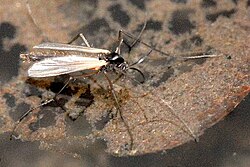| Tribelos | |
|---|---|
 | |
| Tribelos intextum, Belgium | |
| Scientific classification | |
| Domain: | Eukaryota |
| Kingdom: | Animalia |
| Phylum: | Arthropoda |
| Class: | Insecta |
| Order: | Diptera |
| Family: | Chironomidae |
| Subfamily: | Chironominae |
| Tribe: | Chironomini |
| Genus: | Tribelos Townes, 1945 |

Tribelos is a genus of non-biting midges in the subfamily Chironominae of the bloodworm family Chironomidae. [1] [2] [3]